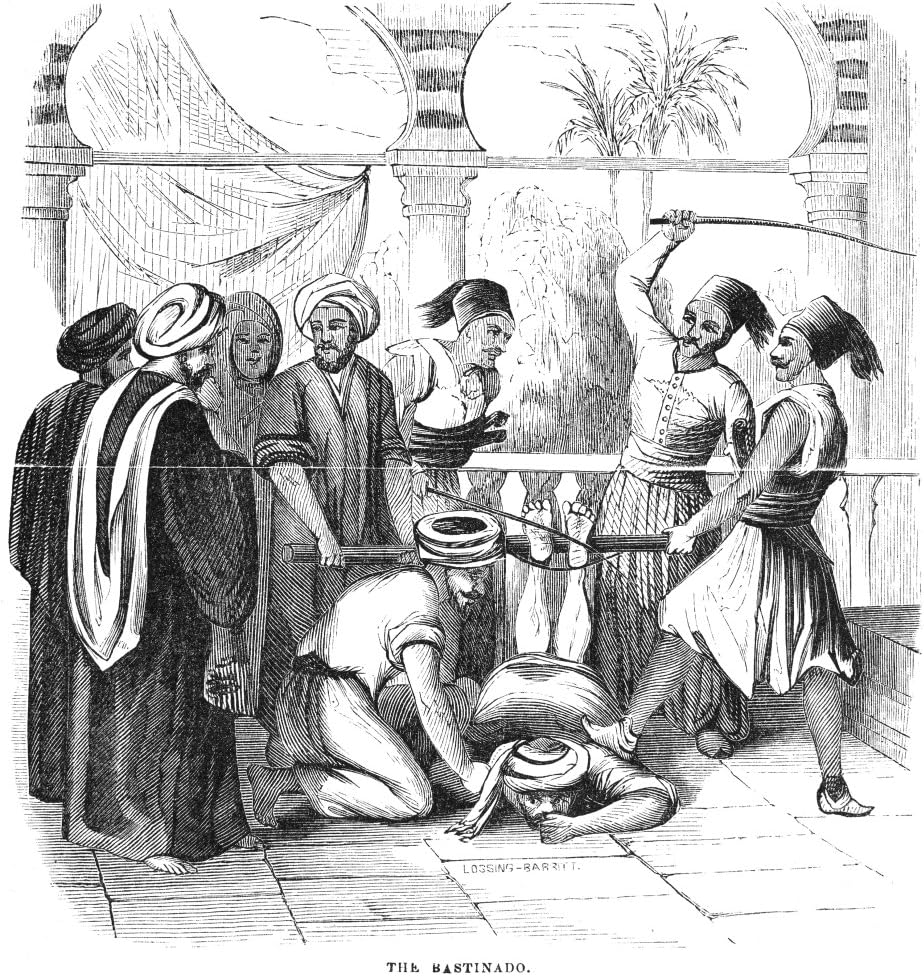“I will deal in poison with thee, or in bastinado, or in steel…” says Touchstone threatening William in As You Like it, Act V, Shakespeare.
“He was forthwith laid down on the deck, and had his arms turned and held behind him, one man sitting on his legs and another at his head; and in this posture, the captain with a great rope gave him a hundred blows.” A faithful account of the religion and manners of the Mahometans, Joseph Pitts, 1731
In my new novel, “White Slaves: 15 Years a Barbary Slave”, young Felix is punished by Captain Murad with a bastinado during a horrific voyage down the coast of France and Spain. The captain tries to force the young man to tell him the truth about the murder of a woman in the hold of his ship. A bastinado is a beating of the soles of the feet with a cane, a leather whip, or a flexible wooden bat. It was often favoured as a form of torture because, although extremely painful, it leaves few physical marks. The prisoner is immobilized by securing the feet in stocks, locking the legs into an elevated position, or hanging upside-down. The Persian term falaka or falanga referred to a wooden plank which was used to secure the feet prior to beating.
In Europe, foot whipping dates back to the early 16th century and has been used frequently in the 20th century: in Germany and in the occupied countries during WWII, in Greek, Spanish and Turkish prisons, in Palestine by the British, and in Algeria by the French. It was used in Brazil and in the American South against slaves where it was called “clean beating” compared to the harsher, more visually abhorrent forms of flagellation. The German term is bastonade from the Italian word bastonada (striking with a cudgel) or sohlenstreich (striking the soles of the feet). Up until the 1960s, it was used as punishment in juvenile institutions in Massachusetts and in Austria.
A lot of people today would find the bastinado barbaric, a relic of the Middle Ages along with the rack, the thumbscrews, the wheel, the pillory, and the burning of victims at the stake but, of course, modern minds have come up with a host of new ways to torture their victims. These include sexual assault, beatings, electric shocks, rape, sleep deprivation, mock executions and waterboarding. It is terrible to say this, but the torture of prisoners is more widespread than ever before in countries like Syria, Egypt, Turkey, Russia, Myanmar, China and North Korea. In many ways, we are no better than our ancestors during the religious wars of the 16th and 17th centuries.
It is shocking that the Saudi crown prince, Mohammed bin Salman, should be invited to the UK for an official visit after masterminding the killing of Jamal Khashoggi, the Washington Post columnist and dissident; that Xi Jinping of China is treated with respect at international events when we know about the crackdown on the 12 million Uyghurs in China: their indoctrination and internment, and the threats made against their families that occur every day; and that neighbouring countries are starting to normalize their relations with a war criminal like Bashar al-Assad, the Syrian president who forced a war on his people and will forever have blood on his hands. If you live in any of the countries above or in the refugee camps surrounding their borders, the world is just as dark today as it was back in the time of the Inquisition. We are no longer safe in the modern world. We cannot simply ignore the horrors going on around the globe and do nothing.
The attack on human rights around the world is far more important and dangerous to planet Earth than climate change, LGBTQ rights and woke lunacies that people obsess about. We may be facing World War III in the next few years and the democracies of the world need to stand together against those autocratic countries that abuse and torture their own citizens.


Comments ()